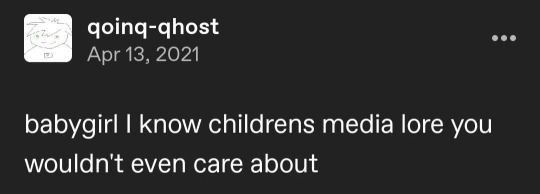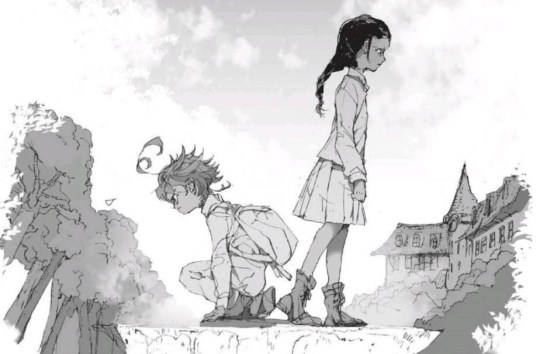#and Anime Feminist's “Emma’s Choice: The gender-norm nightmare at the heart of The Promised Neverland” are good follow-up reads to this
Note
Your analyses are the best. They are so fun to read and I over think everything afterwarrs

Thank you!
For analyses above my level, I highly recommend checking out these if you haven't already read them:
The two chapters of Kei Toda's Reading The Promised Neverland with a British/American Literature Scholar (2020) that have been translated into English by fans (Chapter 2: Religion by @thathilomgirl & @0hana0fubuki0 | Chapter 3: Gender by @1000sunnygo)
Anime Feminist's "Emma’s Choice: The gender-norm nightmare at the heart of The Promised Neverland" article (2018) (good follow-up to Toda's chapter on gender)
Jackson P. Brown's "Thoughts on… The Promised Neverland, and Black Women in Manga" (2018) blog post and Zeria's video essay/blog post (2019) on Krone's depiction
Jairus Taylor's "The Unfulfilled Potential of The Promised Neverland Anime" (2021) which made me more open to the idea of a remake of S1
For tumblr posts (some of these I'm linking through my blog because I either had a minor link addition or think the OP's/prev's tags deserve to be seen and rebloggable, but you can just click through to the original post):
@puff-poff's exploration of the demon world's culture (Part 1 & Part 2)
@just-like-playing-tag's examination of the farm system, Emma character analysis launched by a minute change in S2e02, and mini-Isabella analysis regarding her treatment of Ray (along with her blog just being a wealth of knowledge in general)
@hylialeia's post on the series' handling of Norman's plan/the oppressed and oppressors
@avadescent's analysis of the S2 ED album art (Norman and Emma are perpendicular; Emma and Ray are parallel.)
@linkspooky has a lot of analyses from when the series was running but special mention to this analysis of Norman's character
@vobomon also has a lot but special mention to her Norman is autistic and Norman has PTSD posts
@goldiipond's "Ray is autistic" essay
@emmaspolaroid with some of the best Emma and Emma & Isabella meta in general
@nullaby's post on Isabella and Ray's relationship
#The Promised Neverland#Yakusoku no Neverland#YnN#TPN#TPN Meta#Character Analysis#FSS Chatter#FSS Asks#TPN Krone#Sister Krone#Kei Toda#Reading The Promised Neverland with a British/American Literature Scholar#definitely forgetting some but these are the ones that first come to mind and I could easily find again#there's also some fanfics out there that are so foundational to me for my interpretations of the characters#(𝐵𝑒𝑡𝑤𝑒𝑒𝑛 𝑌𝑜𝑢𝑟 𝐹𝑖𝑛𝑔𝑒𝑟𝑠‚ 𝐵𝑒𝑡𝑤𝑒𝑒𝑛 𝑡ℎ𝑒 𝐿𝑖𝑛𝑒𝑠 my beloved <3; along with bsa's and sae's works and others)#but this is already a bit of reading#also probably a number of discussions on TPNtwt that I'm missing out on but I fucking abhor the format for long-form discussion#even with thread unrollers#Sunny idk if it's just my browser but I think some of the pic links on your blogspot are breaking </3#if you take a shot for every time I mention on this blog how I still can't believe the S2 ED album art is real you'll get alcohol poisoning
34 notes
·
View notes
Text
[Feature] Emma’s Choice: The gender-norm nightmare at the heart of The Promised Neverland

CONTENT WARNING: Discussions of sexism and violence against children; disturbing imagery. SPOILERS for The Promised Neverland, Volumes 1-5 (Chapters 1-38).
Since it began serialization in Viz’s Shonen JUMP, The Promised Neverland has garnered well-deserved praise for its twisting narrative, tense story beats, and compelling characters. But this series is more than a page-turning thriller. What begins as a sharply crafted horror story soon reveals itself to be a sophisticated critique on restrictive social practices—including the hellishly limited roles expected of girls.
The Promised Neverland follows Emma and her foster siblings, who live a seemingly idyllic life with their foster mother Isabella as they await adoption. Their paradise is abruptly shattered, however, when Emma and Norman witness the truth: they’re not being adopted, but shipped off to become high-grade food for literal monsters. Horrified, they and their siblings plan their escape.
The most effective horror stories aren’t about the monster itself, but about the fear that monster represents. These fears can range from the neutral (death), the regressive (xenophobia), or the progressive (the effects of bigotry), but they’re always tapping into some broader anxiety felt by the target audience. Sometimes a cigar is just a cigar, but a good monster is never just a monster.
Because monsters serve as metaphors, they also have the potential to map onto a variety of ideas or concerns. The nightmare depicted in The Promised Neverland serves as social commentary, but that doesn’t mean it’s only one social commentary.
Read it at Anime Feminist!
62 notes
·
View notes